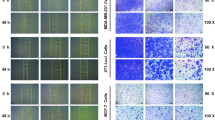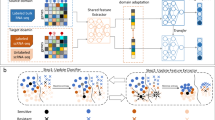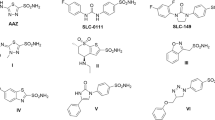Abstract
Recent evidence shows that dopamine D2-like receptor (D2DR) antagonists, such as trifluoperazine and thioridazine, are effective for cancer therapy and inhibition of cancer stem-like cells (CSCs). In this study, we investigated the anti-cancer effects of combination therapy of dexamethasone (DEX) and sulpiride (SUL), an atypical antipsychotic, against drug-resistant and metastatic breast cancers and further explored the underlying mechanisms. Oral administration of SUL (25, 100 mg·kg−1·d−1) alone did not inhibit the tumor growth in human breast cancer MCF-7/Adr xenograft model, but dose-dependently decreased the proportion of CSCs in vitro and in vivo. In contrast, combination therapy of SUL (50 mg·kg−1·d−1) and DEX (8 mg·kg−1·d−1) markedly suppressed the tumor growth in MCF-7/Adr xenograft model with little systemic toxicity and lung metastasis in murine metastatic breast cancer 4T1 xenograft model. Among the metastasis-associated biomarkers analyzed, the combination therapy significantly decreased the levels of MMP-2, but increased E-cadherin levels in 4T1 xenograft tumors. Moreover, the combination therapy significantly inhibited the cell colony formation, migration and invasion of 4T1 and human breast cancer MDA-MB-231 cells in vitro. Addition of a specific D2DR agonist 7-OH-DPAT to the combination therapy reversed the enhanced anti-cancer effects in vivo and CSC population loss in tumor tissues. Our data demonstrate that SUL remarkably enhances the efficacy of DEX in the treatment of drug-resistant and metastatic breast cancer via the antagonism of D2DR, which might result from the eradication of CSCs.
Similar content being viewed by others
Log in or create a free account to read this content
Gain free access to this article, as well as selected content from this journal and more on nature.com
or
References
Siegel RL, Miller KD, Jemal A . Cancer statistics, 2015. CA Cancer J Clin 2015; 65: 5–29.
Gradishar WJ, Anderson BO, Balassanian R, Blair SL, Burstein HJ, Cyr A, et al. Invasive breast cancer version 1.2016, NCCN clinical practice guidelines in oncology. J Natl Compr Canc Netw 2016; 14: 324–54.
Nichols M . New directions for drug-resistant breast cancer: the CDK4/6 inhibitors. Future Med Chem 2015; 7: 1473–81.
Whyte F . Metastasis: the deadly part of cancer. Br J Nurs 1996; 5: 535–8.
Shajahan-Haq AN, Cheema MS, Clarke R . Application of metabolomics in drug resistant breast cancer research. Metabolites 2015; 5: 100–18.
Wang LJ, Li J, Hao FR, Yuan Y, Li JY, Lu W, et al. Dexamethasone suppresses the growth of human non-small cell lung cancer via inducing estrogen sulfotransferase and inactivating estrogen. Acta Pharmacol Sin 2016; 37: 845–56.
Yuan Y, Zhou X, Ren Y, Zhou S, Wang L, Ji S, et al. Semi-mechanism-based pharmacokinetic/pharmacodynamic model for the combination use of dexamethasone and gemcitabine in breast cancer. J Pharm Sci 2015; 104: 4399–408.
Gong H, Jarzynka MJ, Cole TJ, Lee JH, Wada T, Zhang B, et al. Glucocorticoids antagonize estrogens by glucocorticoid receptor-mediated activation of estrogen sulfotransferase. Cancer Res 2008; 68: 7386–93.
Egberts JH, Schniewind B, Pätzold M, Kettler B, Tepel J, Kalthoff H, et al. Dexamethasone reduces tumor recurrence and metastasis after pancreatic tumor resection in SCID mice. Cancer Biol Ther 2008; 7: 1044–50.
Ouatas T, Halverson D, Steeg PS . Dexamethasone and medroxyprogesterone acetate elevate Nm23-H1 metastasis suppressor gene expression in metastatic human breast carcinoma cells: new uses for old compounds. Clin Cancer Res 2003; 9: 3763–72.
Lin YM, Jan HJ, Lee CC, Tao HY, Shih YL, Wei HW, et al. Dexamethasone reduced invasiveness of human malignant glioblastoma cells through a MAPK phosphatase-1 (MKP-1) dependent mechanism. Eur J Pharmacol 2008; 593: 1–9.
Yeh CT, Wu AT, Chang PM, Chen KY, Yang CN, Yang SC, et al. Trifluoperazine, an antipsychotic agent, inhibits cancer stem cell growth and overcomes drug resistance of lung cancer. Am J Respir Crit Care Med 2012; 186: 1180–8.
Sachlos E, Risueño RM, Laronde S, Shapovalova Z, Lee JH, Russell J, et al. Identification of drugs including a dopamine receptor antagonist that selectively target cancer stem cells. Cell 2012; 149: 1284–97.
Lu M, Li J, Luo Z, Zhang S, Xue S . Wang K, et al. Roles of dopamine receptors and their antagonist thioridazine in hepatoma metastasis. OncoTargets Ther 2015; 8: 1543–52.
Lai EC, Chang CH, Kao Yang YH, Lin SJ, Lin CY . Effectiveness of sulpiride in adult patients with schizophrenia. Schizophr Bull 2013; 39: 673–83.
Rzewuska M . Sulpiride: the best known atypical, safe neuroleptic drug Review of literature. Psychiatr Pol 1998; 32: 655–66.
Harada M, Bobe I, Saito H, Shibata N, Tanaka R, Hayashi T, et al. Improved anti-tumor activity of stabilized anthracycline polymeric micelle formulation, NC-6300. Cancer Sci 2011; 102: 192–9.
Ricardo S, Vieira AF, Gerhard R, Leitão D, Pinto R, Cameselle-Teijeiro JF, et al. Breast cancer stem cell markers CD44, CD24 and ALDH1: expression distribution within intrinsic molecular subtype. J Clin Pathol 2011; 64: 937–46.
Wang S, Mou Z, Ma Y, Li J, Li J, Ji X, et al. Dopamine enhances the response of sunitinib in the treatment of drug-resistant breast cancer: Involvement of eradicating cancer stem-like cells. Biochem Pharmacol 2015; 95: 98–109.
Li X, Lewis MT, Huang J, Gutierrez C, Osborne CK, Wu MF, et al. Intrinsic resistance of tumorigenic breast cancer cells to chemotherapy. J Natl Cancer Inst 2008; 100: 672–9.
Ji XW, Chen GP, Song Y, Hua M, Wang LJ, Li L, et al. Intratumoral estrogen sulfotransferase induction contributes to the anti-breast cancer effects of the dithiocarbamate derivative TM208. Acta Pharmacol Sin 2015; 36: 1246–55.
Luo KW, Yue GG, Ko CH, Gao S, Lee JK, Li G, et al. The combined use of Camellia sinensis and metronomic zoledronate in 4T1 mouse carcinoma against tumor growth and metastasis. Oncol Rep 2015; 34: 477–87.
Peng CT, Lin HC, Lin YJ, Tsai CH, Yeh TF . Early dexamethasone therapy and blood cell count in preterm infants. Pediatrics 1999; 104: 476–81.
Iwanaga K, Honjo T, Miyazaki M, Kakemi M . Time-dependent changes in hepatic and intestinal induction of cytochrome P450 3A after administration of dexamethasone to rats. Xenobiotica 2013; 43: 765–73.
Hsieh TH, Hsu CY, Tsai CF, Chiu CC, Liang SS, Wang TN, et al. A novel cell-penetrating peptide suppresses breast tumorigenesis by inhibiting β-catenin/LEF-1 signaling. Sci Rep 2016; 6: 19156.
Fan CC, Lee LY, Yu MY, Tzen CY, Chou C, Chang MS . Upregulated hPuf-A promotes breast cancer tumorigenesis. Tumour Biol 2013; 34: 2557–64.
Snyder KA, Hughes MR, Hedberg B, Brandon J, Hernaez DC, Bergqvist P, et al. Podocalyxin enhances breast tumor growth and metastasis and is a target for monoclonal antibody therapy. Breast Cancer Res 2015; 17: 46.
Sinha S, Khan S, Shukla S, Lakra AD, Kumar S, Das G, et al. Cucurbitacin B inhibits breast cancer metastasis and angiogenesis through VEGF-mediated suppression of FAK/MMP-9 signaling axis. Int J Biochem Cell Biol 2016; 77: 41–56.
Mani SA, Guo W, Liao MJ, Eaton EN, Ayyanan A, Zhou AY, et al. The epithelial-mesenchymal transition generates cells with properties of stem cells. Cell 2008; 133: 704–15.
Thiery JP, Acloque H, Huang RY, Nieto MA . Epithelial-mesenchymal transitions in development and disease. Cell 2009; 139: 871–90.
Kessenbrock K, Plaks V, Werb Z . Matrix metalloproteinases: regulators of the tumor microenvironment. Cell 2010; 141: 52–67.
Qian X, Anzovino A, Kim S, Suyama K, Yao J, Hulit J, et al. N-cadherin/FGFR promotes metastasis through epithelial-to-mesenchymal transition and stem/progenitor cell-like properties. Oncogene 2014; 33: 3411–21.
Yang JT, Lee TH, Lee IN, Chung CY, Kuo CH, Weng HH . Dexamethasone inhibits ICAM-1 and MMP-9 expression and reduces brain edema in intracerebral hemorrhagic rats. Acta Neurochir (Wien) 2011; 153: 2197–203.
Davies S, Dai D, Pickett G, Leslie KK . Gene regulation profiles by progesterone and dexamethasone in human endometrial cancer Ishikawa H cells. Gynecol Oncol 2006; 101: 62–70.
Jones J, Walker R . Cell-cell and cell-stromal interactions in breast cancer invasion and metastasis (review). Int J Oncol 1997; 11: 609–16.
Donnenberg VS, Donnenberg AD . Multiple drug resistance in cancer revisited: the cancer stem cell hypothesis. J Clin Pharmacol 2005; 45: 872–7.
Lawson JC, Blatch GL, Edkins AL . Cancer stem cells in breast cancer and metastasis. Breast Cancer Res Treat 2009; 118: 241–54.
Geng SQ, Alexandrou AT, Li JJ . Breast cancer stem cells: Multiple capacities in tumor metastasis. Cancer Lett 2014; 349: 1–7.
Li S, Li Q . Cancer stem cells and tumor metastasis (Review). Int J Oncol 2014; 44: 1806–12.
Liu H, Patel MR, Prescher JA, Patsialou A, Qian D, Lin J, et al. Cancer stem cells from human breast tumors are involved in spontaneous metastases in orthotopic mouse models. Proc Natl Acad Sci U S A 2010; 107: 18115–20.
Liu S, Wicha MS . Targeting breast cancer stem cells. J Clin Oncol 2010; 28: 4006–12.
Abubaker K, Latifi A, Luwor R, Nazaretian S, Zhu H, Quinn MA, et al. Short-term single treatment of chemotherapy results in the enrichment of ovarian cancer stem cell-like cells leading to an increased tumor burden. Mol Cancer 2013; 12: 24.
Chinchar E, Makey KL, Gibson J, Chen F, Cole SA, Megason GC, et al. Sunitinib significantly suppresses the proliferation, migration, apoptosis resistance, tumor angiogenesis and growth of triple-negative breast cancers but increases breast cancer stem cells. Vascular Cell 2014; 6: 12.
Conley SJ, Gheordunescu E, Kakarala P, Newman B, Korkaya H, Heath AN, et al. Antiangiogenic agents increase breast cancer stem cells via the generation of tumor hypoxia. Proc Natl Acad Sci U S A 2012; 109: 2784–9.
Luedi MM, Singh SK, Mosley JC, Hatami M, Gumin J, Sulman EP, et al. A dexamethasone-regulated gene signature is prognostic for poor survival in glioblastoma patients. J Neurosurg Anesthesiol 2017; 29: 46–58.
Du L, Rao G, Wang H, Li B, Tian W, Cui J, et al. CD44-positive cancer stem cells expressing cellular prion protein contribute to metastatic capacity in colorectal cancer. Cancer Res 2013; 73: 2682–94.
Acknowledgements
This study was supported by the projects of the National Natural Science Foundation of China (NSFC) (Grant No 81473277, 81273583, and 81673500). The first two authors of this article are sponsored by Pfizer.
Author information
Authors and Affiliations
Corresponding authors
Additional information
Supplementary information is available at the website of Acta Pharmacologica Sinica.
Supplementary information
Supplementary Figure S1
The anti-cancer effects of monotherapy and co-treatment of SUL and DEX on MCF-7 parental cells and MCF-7/Adr cells. (JPG 3299 kb)
Rights and permissions
About this article
Cite this article
Li, J., Yao, Qy., Xue, Js. et al. Dopamine D2 receptor antagonist sulpiride enhances dexamethasone responses in the treatment of drug-resistant and metastatic breast cancer. Acta Pharmacol Sin 38, 1282–1296 (2017). https://doi.org/10.1038/aps.2017.24
Received:
Accepted:
Published:
Issue date:
DOI: https://doi.org/10.1038/aps.2017.24
Keywords
This article is cited by
-
Neuroscience of cancer: unraveling the complex interplay between the nervous system, the tumor and the tumor immune microenvironment
Molecular Cancer (2025)
-
Neurotransmitters: an emerging target for therapeutic resistance to tumor immune checkpoint inhibitors
Molecular Cancer (2025)
-
Repurposing of nervous system drugs for cancer treatment: recent advances, challenges, and future perspectives
Discover Oncology (2025)
-
Therapeutic strategies for colorectal cancer: antitumor efficacy of dopamine D2 receptor antagonists
Toxicological Research (2024)
-
The tumor-nerve circuit in breast cancer
Cancer and Metastasis Reviews (2023)



